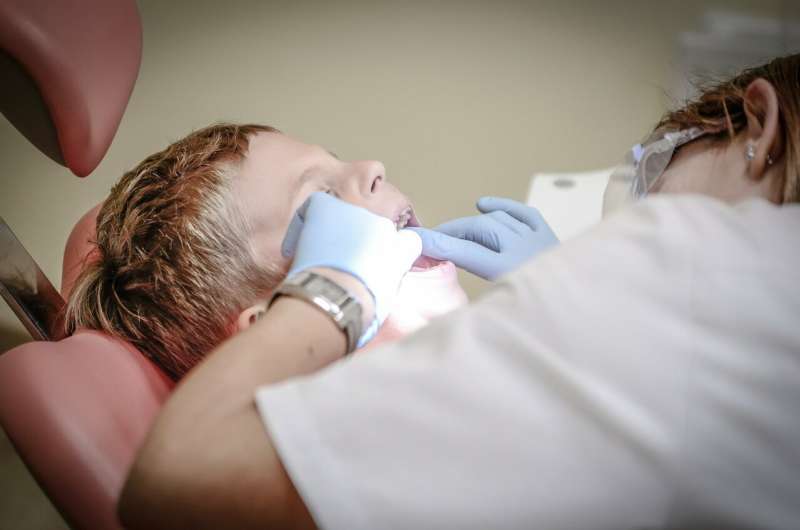This article has been reviewed according to Science X's editorial process and policies. Editors have highlighted the following attributes while ensuring the content's credibility:
fact-checked
peer-reviewed publication
trusted source
proofread
Children living in deprived areas are three times more likely to need dental extractions in hospital, finds study

Researchers at Queen Mary University of London have found that children living in areas with high levels of deprivation are three times more likely to have severe tooth decay that requires a dental extraction in hospital, compared with children living in more affluent areas. The findings highlight an urgent need for equitable access to preventive dentistry.
In the study, published in BMJ Public Health, researchers analyzed de-identified GP and hospital records for 600,000 children between the ages of five and 16 living in North East London. During the five-year study period, one in 200 children had at least one tooth removed under a general anesthetic, which must be done in a hospital setting. Most of those children had multiple teeth extracted.
The study findings demonstrate major socioeconomic and ethnic inequalities in severe tooth decay in children, which is preventable through access to NHS dentists, and policies such as toothbrushing in schools and control of sugar in food and drinks.
- Children living in areas with the highest proportion of low-income households were three times more likely to require a dental extraction, compared with those living in areas with the lowest proportion of low-income households.
- Children from some ethnic groups were more likely to need a dental extraction, compared with children from white British ethnic groups:
- White Irish: twice as likely;
- Bangladeshi: 1.5 times more likely;
- Pakistani: 1.4 times more likely.
- Children living with obesity were less likely to require a dental extraction than children with healthy weight. More research is needed to replicate and understand this finding.
The researchers also examined the data by North East London borough, comparing rates of children's dental extractions with access to NHS general dental practitioners. After adjusting for deprivation and ethnic group, the highest risk of hospital dental extraction was for children in Tower Hamlets, which also has the lowest general dental practitioner attendance in North East London.
Conversely, children living in Redbridge, Havering, and Barking & Dagenham had the lowest risk of hospital dental extraction—these areas have the highest proportion of five-year-olds accessing general dental practitioner services. Additionally, the 2022 National Dental Epidemiology Program (NDEP) oral health survey found that only 13% of decayed teeth in five-year-old children in London had been filled.
This study is the first to analyze inequalities in children's tooth extractions under general anesthesia by ethnic group in such granular detail, revealing a difference in outcomes between white Irish and white British groups, and between Bangladeshi, Pakistani and Indian groups. By linking hospital data to GP records, which include 16 categories for ethnic group, researchers were able to reveal ethnic inequalities that are less apparent when using the broader ethnicity categories used in previous research.
Vanessa Muirhead, Co-author and Reader and Honorary Consultant in Dental Public Health at Queen Mary, said, "Sadly, our findings demonstrate wide socioeconomic and ethnic inequalities related to access to dental care and outcomes.
"Tooth extraction is a last resort, but when families have difficulty accessing timely preventive and treatment services, dental problems can progress until children need more serious and costly interventions such as multiple tooth extractions under general anesthesia."
Nicola Firman, lead author and Health Data Scientist at Queen Mary, said, "Linking health data from different settings has allowed us to see inequalities in the dental care system more clearly.
"Our findings point to an urgent need for equitable access to preventive general dental services, and interventions that are targeted at the wider determinants of dental health."
Christopher Tredwin, Dean and Director of the Institute of Dentistry at Queen Mar, said, "This research highlights clear oral health inequalities, which we are also acutely aware of through our longstanding service of the local community.
"In partnership with Barts Health NHS Trust, the Queen Mary Institute of Dentistry opened a new dental outreach clinic in Kenworthy Road, Homerton, earlier this year.
"It is now providing quicker and easier access to dental care in the local area, while our dental and therapy students learn to treat children in these primary care settings. Through the outstanding work of our students at these clinics, we hope to mitigate the effects of unequal access to general dentistry in North East London and help to provide care for those who need it most."
Victoria King, Director of Funding and Impact at Barts Charity, said, "This important work, supported by Barts Charity, has demonstrated that there are major inequalities linked to severe tooth decay for children in East London, which could be preventable. Supporting research to understand these health inequalities is key to making better health care possible for our diverse East London population."
More information: Inequalities in children's tooth decay requiring dental extraction under general anaesthetic: a longitudinal study using linked electronic health records, BMJ Public Health (2024). DOI: 10.1136/bmjph-2023-000622



















